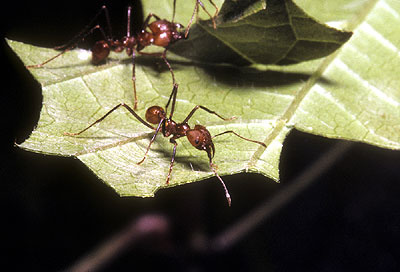
More about Leaf-Cutter Ant
Habitat
These ants are present in many forest and agricultural situations in humid areas.
Range
They can be found in regions of Central and South America with humid tropical forest.
Physical Description
The largest member of the colony is the queen, who can be twice as big as the largest soldier and has a gigantic abdomen full of eggs waiting to be laid. Males, which are routinely born when breeding season comes, are also large but not as enormous as mature queens. Soldiers are the largest workers that look big for an ant, even without their smaller companions for comparison. A soldier is reddish, with a huge, heart-shaped head, giant mandibles, long legs and a bristly body. Media workers are half as big, but still have visible mandibles. The smallest participants of this colony are the minima, who look the darkest and most proportionate.
Biology and Natural History
These ants are a favorite sight in tropical American forests as they march down tree trunks and through the forest carrying small leaf bits on their backs like sails. The natural assumption is that they eat the leaves, but these ants are gardeners. Their main food is a fungus that they cultivate underground in their colonies. This soft, spongy fungus grows on leaves, which is why the ants go to such lengths to obtain leaves for their gardens.
The colony designates a certain tree as the current primary leaf source. The media workers communicate through pheromones and shuttle back and forth between a tree and the nest. Medias do the actual leaf-cutting for the colony. Soldier ants patrol these lines of workers for protection. When the media workers return to the nest, minima accept or reject the leaf parts. Inside the nest, the minima give the main direct care to the gardens. They clean the new leaves, chew them into smaller pieces, and add feces and saliva to make a sticky material, which they attach to the fungus. The fungus grows over the new leaf material, and when it matures the ants collect the hyphae to eat. The minima also take care of the nest’s developing young.
Nests are complex systems of tunnels and chambers underground. Large, mature ones can function with millions of workers and the mound may cover many square meters of ground. The chambers are mostly occupied by the fungus gardens, but others are for raising the young and one houses the queen.
Over time, this species of ant and this species of fungus have evolved to form a very tight co-dependency. The fungus has lost the ability to reproduce on its own, so it does not exist in the forest where the ants are not taking care of it. This means that starting a new colony is a bit complicated. Before a new queen leaves the nest where she was born, she takes a piece of fungus into a pouch in her abdomen. Then at dawn she joins the other queens and males that are congregating in the air to mate. After mating, the queen returns to the ground, digs a small tunnel, and tries to begin a garden and lay eggs. If the queen is not able to keep her fungus garden alive, she will starve to death. If things go well, the fungus and the queen will stay alive until the first workers emerge after 4 or 5 weeks and begin to care for her and feed the fungus. It takes a colony 3 or 4 years to mature.
Diet
The primary food consumed by these ants is the fungus they garden.
Height/Weight
On average, a minima is 2 mm long, a media worker is 10 mm long, and the largest soldier can reach 20 mm in length. Reproductive males are even bigger, but the queens take the crown at 30 to 40 mm from head to wing tips.
Taxonomy
Order: Hymenoptera
Family: Formicidae
Sources
Hogue, Charles L. Latin American Insects and Entomology. University of California Press: Berkely and Los Angeles, 1993.
Stevens, G. C. in Janzen, Daniel H. Costa Rican Natural History. Chicago: University of Chicago Press, 1983.
-Amy Strieter, Wildlife Writer
Similar Profiles
It's more than just having a good time or visiting beautiful places (although that's absolutely a part of it!), it's about being part of a unique experience that stays with you.



